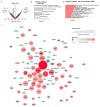T-cell invigoration to tumour burden ratio associated with anti-PD-1 response
- PMID: 28397821
- PMCID: PMC5554367
- DOI: 10.1038/nature22079
T-cell invigoration to tumour burden ratio associated with anti-PD-1 response
Abstract
Despite the success of monotherapies based on blockade of programmed cell death 1 (PD-1) in human melanoma, most patients do not experience durable clinical benefit. Pre-existing T-cell infiltration and/or the presence of PD-L1 in tumours may be used as indicators of clinical response; however, blood-based profiling to understand the mechanisms of PD-1 blockade has not been widely explored. Here we use immune profiling of peripheral blood from patients with stage IV melanoma before and after treatment with the PD-1-targeting antibody pembrolizumab and identify pharmacodynamic changes in circulating exhausted-phenotype CD8 T cells (Tex cells). Most of the patients demonstrated an immunological response to pembrolizumab. Clinical failure in many patients was not solely due to an inability to induce immune reinvigoration, but rather resulted from an imbalance between T-cell reinvigoration and tumour burden. The magnitude of reinvigoration of circulating Tex cells determined in relation to pretreatment tumour burden correlated with clinical response. By focused profiling of a mechanistically relevant circulating T-cell subpopulation calibrated to pretreatment disease burden, we identify a clinically accessible potential on-treatment predictor of response to PD-1 blockade.
Figures














References
-
- Fridman WH, Pagès F, Sautès-Fridman C, Galon J. The immune contexture in human tumours: impact on clinical outcome. Nat Rev Cancer. 2012;12:298–306. - PubMed
Publication types
MeSH terms
Substances
Grants and funding
- F32 AG047773/AG/NIA NIH HHS/United States
- U19 AI117950/AI/NIAID NIH HHS/United States
- KL2 TR001879/TR/NCATS NIH HHS/United States
- T32 CA009140/CA/NCI NIH HHS/United States
- P01 CA114046/CA/NCI NIH HHS/United States
- K08 AI114852/AI/NIAID NIH HHS/United States
- T32 2T32CA009615-26/NH/NIH HHS/United States
- P30 CA008748/CA/NCI NIH HHS/United States
- U19 AI082630/AI/NIAID NIH HHS/United States
- P50 CA174523/CA/NCI NIH HHS/United States
- P30 CA016520/CA/NCI NIH HHS/United States
- T32 CA009615/CA/NCI NIH HHS/United States
- P01 AI108545/AI/NIAID NIH HHS/United States
- R01 AI105343/AI/NIAID NIH HHS/United States
LinkOut - more resources
Full Text Sources
Other Literature Sources
Medical
Molecular Biology Databases
Research Materials

